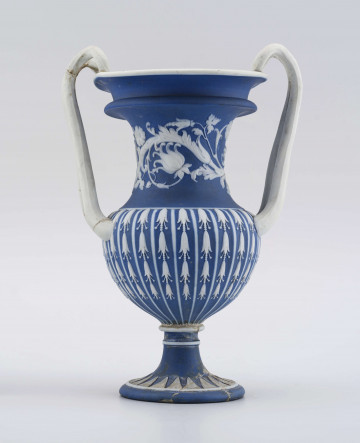
Vase
1800 — 1820
National Museum in Lublin
Part of the collection: English stoneware – Wedgwood
Wedgwood porcelain from a manufactory located in Staffordshire is one of the most famous in the world. The factory was founded in 1759 by Josiah Wedgwood I and became famous for its ceramic wares, dating back almost two hundred and fifty years.
The Wedgwood factory was initially known for its delicate cream-toned faience, which became extremely popular with customers in the 18th century. Dependent on a wealthy and influential clientele, Wedgwood could not afford to let his wares fall out of favour, but he remained alert to any changes in fashion. In one letter he wrote to his own, Thomas Bentley, that Lady Dartmouth and her acquaintances were slowly growing tired of the uniform tableware and were looking for new and more exciting designs for their country residences: "You know, however, what Lady Dartmouth reports to us - that she and her friends are already tired of the cream colour" (G. Blake Roberts, Josiah Wedgwood I – człowiek garncarz [Josiah Wedgwood I - Potter-Man, [in:] Wedgwood. Ceramika XVII–XX wieku [Wedgwood. Ceramics of the 17th-20th centuries], Warsaw 2002, p. 23). For that reason, the factory began producing new masses, which were given different colours depending on the proportions of ingredients added to the clay and the glazes used.
In a short period, Wedgwood's new products again aroused great interest among the clientele of the upper classes. Jasper stoneware, surface-dyed black and Pear White decoration, perfectly harmonises with the then-new neoclassical style. "Black is certain and will last forever" were the words spoken by Josiah Wedgwood, confident of the newly introduced design. The manufactory's constant striving to improve its products resulted in the production of all kinds of decorative vases that were part of the furnishings of prominent English families. Sir Charles Bingham, an Irish aristocrat, reported: "[...] several persons have seen our vases, and a sort of vase madness seems to have broken out" (Ibidem, p. 24).
Author / creator
Dimensions
cały obiekt: width: 16,5 cm
Object type
dish
Technique
ceramic technique
Material
stoneware, silver
Creation time / dating
Creation / finding place
Owner
The National Museum in Lublin
Identification number
Location / status